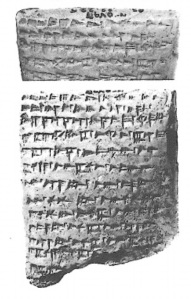 The ancient world is full of rebellion. In my patch, the Bronze Age Near East, the world was one of dominant ‘great kings’ with imperial aspirations. In the southern Mediterranean was Egypt, ancient and arrogant; in the east, Babylon and later Assyria; in the north, the Hurrian kingdom of Mitanni, which was later supplanted by the Hittite Empire. Most histories of the Bronze Age tell political and military tales of the waxing and waning of these great empires and the great campaigns of their rulers – people like Ramesses II or Šuppiluliuma I.
The ancient world is full of rebellion. In my patch, the Bronze Age Near East, the world was one of dominant ‘great kings’ with imperial aspirations. In the southern Mediterranean was Egypt, ancient and arrogant; in the east, Babylon and later Assyria; in the north, the Hurrian kingdom of Mitanni, which was later supplanted by the Hittite Empire. Most histories of the Bronze Age tell political and military tales of the waxing and waning of these great empires and the great campaigns of their rulers – people like Ramesses II or Šuppiluliuma I.
But these empires weren’t all there was, of course. There are other histories to be told. In my research I work on Ugarit, a small but important kingdom on what’s now the Syrian coast. It was militarily weak, but a great trading power. Like many of the small Levantine kingdoms, it found itself charting a dangerous course between the rival influences of its powerful neighbours. In the Middle Bronze Age it seems to have aligned itself with Egypt, but around the middle of the second millennium BC it made the shrewd political decision to ‘invite in’ the Hittites and become a vassal, sparing itself the punishing repercussions of being taken by force.
For the great kings of the Bronze Age, these smaller kingdoms were one of two things – vassals (either their own or someone else’s, assuming they accepted the legitimacy of the claim) or rebels. The latter was not, it is clear, a Good Thing.
These days we love rebels. At least since the twentieth century, western culture has celebrated the underdog who stands up against overwhelming power, especially when that power is grounded in tradition. People are proud to brand themselves ‘rebels’ or part of a ‘resistance’.
 Often rebellion is associated with youth: we take it for granted that young people are by nature rebellious and questioning of the values and authority of their elders. Even those who seek to shut down such dissent often implicitly accept that this is part of the normal behaviour of the young. But youth – especially being teenage – is a highly culturally-constructed category. Arguably, these assumptions tell us more about our own culture than they do about human nature.
Often rebellion is associated with youth: we take it for granted that young people are by nature rebellious and questioning of the values and authority of their elders. Even those who seek to shut down such dissent often implicitly accept that this is part of the normal behaviour of the young. But youth – especially being teenage – is a highly culturally-constructed category. Arguably, these assumptions tell us more about our own culture than they do about human nature.
Continue reading



 It’s time for another under-appreciated ancient monster from antiquity – or rather multiple monsters – because today we’re looking at the Devourers (ʾaklm), demons from Ugaritian mythology who faced off against Baʿal Hadad, the storm-god and patron deity of the city. Unfortunately no pictures of the Devourers exist, so I’ve had to make do with this image of Baʿal himself, on a stele from Ugarit and now in the Louvre.
It’s time for another under-appreciated ancient monster from antiquity – or rather multiple monsters – because today we’re looking at the Devourers (ʾaklm), demons from Ugaritian mythology who faced off against Baʿal Hadad, the storm-god and patron deity of the city. Unfortunately no pictures of the Devourers exist, so I’ve had to make do with this image of Baʿal himself, on a stele from Ugarit and now in the Louvre. There’s a
There’s a 



 I wrote recently about the excellent Lovecraftian board game
I wrote recently about the excellent Lovecraftian board game